
The Business of Fashion
Agenda-setting intelligence, analysis and advice for the global fashion community.

Agenda-setting intelligence, analysis and advice for the global fashion community.

Barneys New York is launching a beauty brand. While some are hopeful it’ll provide a whiff of what the legendary retailer once was, others — myself included — are a bit more cynical.
For me, this brand unfortunately is not the return of the Barneys we knew and loved; it’s merely a cash grab from Authentic Brands Group, which bought the retailer’s intellectual property during the 2019 bankruptcy fire sale (the retailer closed its stores shortly after declaring bankruptcy).
Barneys was always known for its curation, admittedly more so in fashion than beauty, and getting back into beauty could have been an opportunity for the store to do what it did best: identifying and nurturing new and upcoming talent. Except Barneys isn’t coming back as a beauty retailer — it’s coming back as a beauty brand. Through a licensing deal with South Korea-based Gloent Group, Barneys New York Beauty will debut its skin care later this month. A cleanser, an essence, a serum and two moisturisers retail from $48 to $168, with hand cream, lip balms, candles, body care, fragrance and $5.50 bottles of water to come.
Who is the new Barneys hoping to dupe with the old Barneys logo plastered over creams and serums?
ADVERTISEMENT
I’m not sure. Barneys was known for discovering new beauty brands, but it has no track record in being a beauty brand itself — let alone a skin care authority. What we knew as “Barneys” no longer exists; it’s just a licensing agreement, a literal shell of its former self.
Plus, private label brands are notorious for underperforming — especially at the higher end. Even Sephora, which once dedicated significant floor space to its more approachable “Sephora Collection,” significantly reduced its private label footprint years ago. Instead, Sephora’s parent company LVMH created Kendo, a beauty incubator, to develop concepts and brands to be sold at Sephora (and other) stores, like Fenty Beauty. Shoppers don’t want private label Sephora, Saks or Bloomingdales serum; they visit these stores for their collection of outside brands. What’s more, Barneys New York Beauty doesn’t even have the benefit of having Barneys stores as a point of discovery. (In apparel, however, Barneys New York’s private label was a big seller and has recently become hot on the secondhand market, even though those types of lines are simpler fillers for missing product styles at apparel stores.)
Historically, Barneys championed smaller, indie beauty labels. While its beauty floors never generated the attention or sales of apparel and accessories, having a presence at the retailer was important for brand awareness. Selling at Barneys was a signifier that this was a beauty line you should know about.
The retailer also served as a launch pad for founders who didn’t yet have the infrastructure for distribution at a larger retailer. Selling at Sephora, which operates hundreds of doors in the US (and thousands globally), requires a significant buy-in to outfit stores with displays, products, samples and education. Starting slowly at Barneys was an easy way to test retail before expanding distribution.
Several years ago, I saw a brand’s monthly sales report from Barneys, and the amount of product sold was so low that the brand had to be losing money by wholesaling at the store. Another time, a co-founder of a now successful, high-end beauty brand was horrified when, upon meeting for the first time, they told me they were going to launch exclusively with Barneys and my response was “Why?” The executive came from a fashion background, and it was what their mentor, a legend in the apparel world, would have done.
It made sense. Getting people to buy expensive makeup from a brand no one has heard of is hard, and it was even harder about a decade ago. It’s why the optics of counter space at Barneys mattered; it legitimised a fragrance, makeup or skin care brand.
This is what ABG should have focused on when it decided to revive Barneys’ beauty business. The company could have harnessed the existing Barneys shop-in-shops in Saks stores and brought in a selection of other beauty lines, trading on the fallen retailer’s reputation as an early spotter of trends and talent.
Instead, skin care slapped with a Barneys label feels lazy. If someone is going to spend almost $50 on a face wash, will it really be from the Barneys New York line? Probably not.
This month, BoF Careers provides essential sector insights to help beauty professionals decode the industry’s creative landscape.
The skincare-to-smoothie pipeline arrives.
Puig and Space NK are cashing in on their ability to tap the growth of hot new products, while L’Occitane, Olaplex and The Estée Lauder Companies are discovering how quickly the shine can come off even the biggest brands.
Demand for the drugs has proven insatiable. Shortages have left patients already on the medications searching for their next dose and stymied new starters.